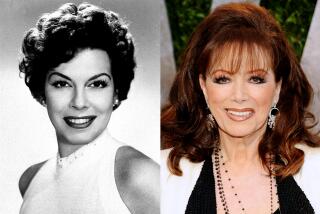Book review: ‘A Woman’s Crusade: Alice Paul and the Battle for the Ballot’ by Mary Walton
- Share via
“A Woman’s Crusade: Alice Paul and the Battle for the Ballot” by Mary Walton (Palgrave/Macmillan: 284 pp., $28.)
Alice Paul was a warrior for women’s suffrage. A Quaker from New Jersey, she went to Swarthmore, the college her maternal grandfather helped to establish. She was a social worker in New York, got her master’s in sociology at the University of Pennsylvania and, on a scholarship awarded by the Society of Friends, went to England to study at a Friends center in Birmingham. Paul had attended women’s suffrage meetings with her mother and friends in America, but it was in England, where women were far more militant in their efforts to secure the vote, that Paul was bitten by what Quakers call “concern,” a “divinely inspired” desire to correct injustice.
Mary Walton, a veteran reporter at the Philadelphia Inquirer, has captured Paul’s fire, her slow burn in “A Woman’s Crusade.” It is the story of the 10 years, between 1909 and 1919, when Paul (1885-1977) and many other women fought for a constitutional amendment that would give women the right to vote. This story is a reminder of the perseverance, the gall, the intelligence it took to obtain what now seems an inalienable right, an obvious pillar of any democracy.
There are many parallels to our time. The women’s movement, started in 1848 by Elizabeth Cady Stanton and Susan B. Anthony, was in a slump in the early 1900s. A woman in 1902 could own property in three-quarters of the states, and in two-thirds she could “keep her paycheck.” (In all but a few states in the South, she could attend a public university. But she could not vote. Suffragettes, much like feminists in our time, were often the subject of public ridicule and contempt.
Part of the genius of the book lies in Walton’s quiet analysis of the methods used by the National American Woman Suffrage Assn. and the National Women’s Party, founded by Paul in 1916. In England, Paul learned how to conduct a “campaign of militancy.” She saw women spit in the faces of policemen, hurl rocks through windows and routinely get dragged off to prison, where they went on hunger strikes and were force-fed. In 1909, after crashing a dinner of government dignitaries in London, hurling shoes and demanding the vote, Paul and a colleague were sentenced to a month of hard labor and were force-fed. Paul returned home to her mother on the family farm in New Jersey amid a great deal of notoriety. “I cannot understand how all this came about,” her mother told the New York Times. “Alice is such a mild-mannered girl.”
Paul faced enormous criticism, from Quakers and from the national media, on her methods — public displays, protests, parades, picketing and, later, banners that became newspaper headlines. But the publicity these efforts garnered gained women entry into the offices of congressmen, funders like Alva Belmont (previously Vanderbilt) and presidents including Woodrow Wilson.
Wilson, originally from the South, was, at first, an equally intractable opponent. He met many times with the suffragists but would not support passage of the amendment Anthony first proposed in 1878. “President Wilson,” one banner read in 1916, “Why do you seek votes from women when you oppose votes for women!” During the years of World War I, suffragists were accused of disloyalty, a lack of patriotism, for not abandoning their cause and for supporting pacifism.
In 1917 after Paul and some 30 protesters were arrested and brutally treated in Virginia’s Occoquan Prison, Wilson finally supported the amendment and encouraged Democrats in the House to do the same. It finally passed the House and Senate in 1919. Wisconsin was the first state to ratify, and women across the country were able to vote in the 1920 election. Paul went on to pursue three law degrees, to draft the 1923 Equal Rights Amendment and then work actively on behalf of women until her death in 1977.
Paul did not work alone. “A Woman’s Crusade” gives us an entire cast of characters, names, like Paul’s, that we were probably not taught in school: Lucretia Mott, Mabel Vernon, Jane Addams, Maud Malone, Anna Shaw, Ida Wells-Barnett and Harriet Stanton Blatch. Walton relies not just on newspapers, biographies, National Women’s Party papers and Paul’s papers at Harvard but on oral histories from the period as well, which give the book an immediacy and vitality.
The history of the passage of the 19th Amendment has many battlefields. The quiet courage of this diminutive Quaker woman can serve as a tuning fork for future generations, unsure in the face of cultural malaise and even ridicule, if what their instincts tell them is indeed unjust and undemocratic. Armed with Alice Paul, things might be different for their daughters and granddaughters.
Salter Reynolds is a writer in Los Angeles.
More to Read
Sign up for our Book Club newsletter
Get the latest news, events and more from the Los Angeles Times Book Club, and help us get L.A. reading and talking.
You may occasionally receive promotional content from the Los Angeles Times.










